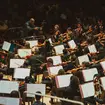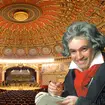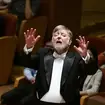Beethoven - Triple Concerto in C
Composed in 1803, Beethoven's Triple Concerto remained unperformed for five years, until its outing at a summer music festival in Vienna in 1808.
The very name Triple Concerto is slightly misleading here. At first glance, you might expect a three-for-the-price-of-one concerto experience, with the violin, cello and piano all happily co-existing as genuine soloists. But what Beethoven gives us is something slightly different.
In many ways, it’s an odd work: there’s very little conversation between the instruments and the orchestra, with nearly everything of interest being played by the soloists. Although that’s to be expected to some degree, all of Beethoven’s other concertos still appear to have orchestral material that, when heard alone, remains pretty compelling. And there’s a real risk that in any performance of the piece the intended interplay between the three soloists is diminished by the individual musicians’ desire to ensure that they come out on top when an audience asks afterwards, ‘Who was the best?’
The finest performances of the Triple Concerto are therefore those where ego is removed, allowing the music to become the sole star. The work has chamber-like qualities; indeed, it’s easy to wonder whether an entire orchestral accompaniment was really necessary – but that was Beethoven’s call to make, not ours.




























